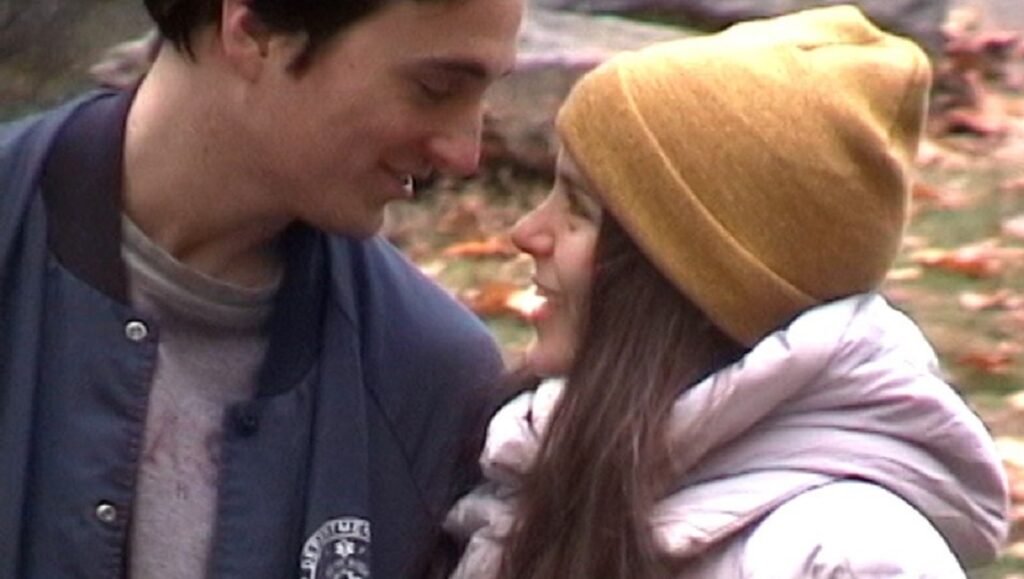While it never quite led to the promise of a more democratic cinematic landscape, there’s now an entire history of digital movie-making that exists both within and apart from the otherwise long-dominant strain of mainstream, narrative Hollywood cinema. Everything from Bill Gunn’s Personal Problems to Michael Snow’s *Corpus Callosum, from Harun Farocki and the Dogme 95 “movement” to Lynch’s Inland Empire and Mann’s late-period trifecta of Miami Vice, Public Enemies, and Blackhat, offers varying approaches to different modes of image-making ranging from the micro-budgeted to the blockbuster. It’s telling, then, that filmmaker Justin Zuckerman has shot his debut feature-length film, Yelling Fire in an Empty Theater, on the extremely outmoded MiniDV format, a low-res predecessor to the much more common HD cameras introduced in the early 2000s. It’s cheap, yes, but there’s an out-of-time quality to MiniDV, a kind of stop-gap between different generations of more ubiquitous technologies, that lends Yelling its unique look — part home movie, part diary, part modern-day period piece. To wit, the film’s protagonist, Lisa (Isadora Leiva), is herself adrift in a transitional phase, a Florida native who has moved to New York City almost on a whim, and who will soon be disabused of any romanticized notions she had of the Big Apple.
Introduced waiting for her luggage at the airport, Lisa is immediately warned by a concerned stranger that she has no idea what she’s in for. Arriving at her new apartment, she meets her roommates Holly (Kelly Cooper) and Bill (Michael Patrick Nicholson). The couple immediately begin arguing, as it seems that Bill had already promised the spare room to a friend of his, while Holly insists that she told him about Lisa’s impending arrival, and besides — she hates his friend. Lisa is dumbfounded, politely trying to extricate herself from the apartment while Holly aggressively demands that she stay for a home-cooked dinner. A smash cut to flimsy plates piled with plain noodles suggests the kind of comedy that Zuckerman is aiming for, pitched somewhere between sitcom zingers and the more observational (and acerbic).
It’s a brief film, barely 80 minutes long, consisting of a series of vignettes that gradually coalesce into a proper narrative: Holly meets up with her college boyfriend, who has moved out to New York ahead of her and has, in her absence, built a new life; meanwhile, Bill’s friend Doug (Colin Burgess) eventually arrives and moves in, despite Holly’s presence, adding yet another volatile element to an already unstable environment. Holly soon joins a temp agency and lands a job as a kind of travel agent, despite having no knowledge of the field and with only a stoned underclassman as a co-worker. The cast is uniformly excellent, bouncing off of each other as they all socialize, quarrel, breakup, and try to get back together. Leiva gives Holly a charming kind of innocence while never condescending to the character or suggesting she’s a wallflower or an idiot, while Cooper and Nicholson nail the love-hate dynamic so common between partners who have overstayed the natural endpoint of a relationship. Zuckerman has a knack for filming dinner scenes and other large gatherings, navigating through bodies to pick up stray lines of dialogue and allowing pressures and resentments to bubble up organically. The audience is frequently as mortified as poor Holly.
This film is being advertised, in part, as a “send up” of mumblecore, the short-lived, sorta-genre that’s had a longer afterlife than heyday. But Zuckerman is too sharp a writer to fall into the awkward pauses and meandering pace of stuff like Swanberg’s early films. It’s unclear how much improvisation was or was not employed during filming, but the movie’s editing is crisp and well-timed, accentuating punchlines and then exiting before a scene overstays its welcome. It’s the film’s visuals that suggest a level of unplanned experimentation. While several camera operators are listed in the credits, there’s no indication of a cinematographer or traditional lighting crew. It stands to reason, then, that principal photography was done entirely with available light, which — mixed with the MiniDV camera — leads to variable image qualities. A scene of Holly standing in Times Square finds her surrounded by huge LED screens, which become blown-out pools of undulating white noise, all bleeding together. Other sequences offer all manner of digital noise and pixelated patterns, sometimes obscuring faces while other times luxuriating in the warm glow of a lamp or soft overhead light. There’s a lovely moment of Holly and Doug on a rooftop that shows the poetic capabilities of this old tech in even the darkest situations, the city’s skyline shimmering in the background like stars while faces emerge from a kind of makeshift chiaroscuro. Put more directly, there’s much to like here, including an abrupt ending that arrives literally out of nowhere. It’s a gambit bound to irk some viewers, but the sudden, unexpected act merely crystallizes the low-grade fear and anxiety that has already permeated the rest of the picture. Zuckerman ends things on a cryptic note, Holly floating in a liminal space of uneasy stasis. Frankly, it’s hard not to relate.
You can currently stream Yelling Fire in an Empty Theater on Fandor.
Published as part of InRO Weekly — Volume 1, Issue 3.


Comments are closed.